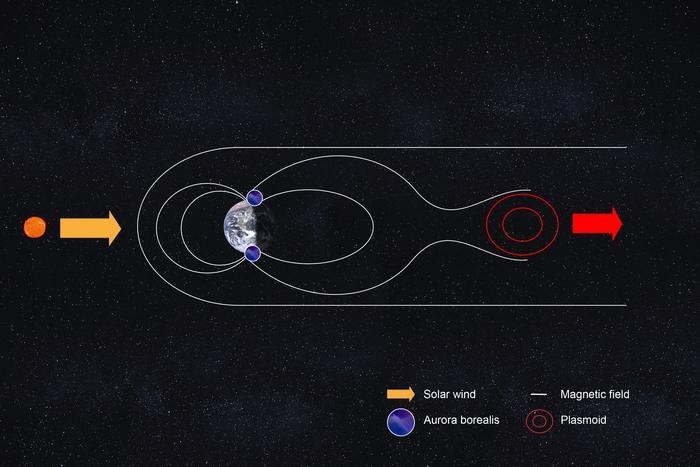The way in which plasma eruptions form in near-Earth space has long puzzled researchers. However, a model named Vlasiator that has recently been engineered at the University of Helsinki is now able to simulate near-Earth space.

Plasma eruptions in near-Earth space. Image Credit: Jani Närhi
The newly developed model illustrated that the two central theories on the incident of eruptions are concurrently valid: eruptions are described by both kinetic instabilities and magnetic reconnection.
Rapid plasma eruptions called plasmoids occur on the magnetosphere’s nightside. Plasmoids are also linked to the abrupt brightening of the aurora. At the University of Helsinki, the space physics research group has been investigating and simulating these difficult-to-predict eruptions in near-Earth space using the Vlasiator model.
The phenomena associated with plasmoids cause the most intense but the least predictable magnetic disturbances, which can cause, for example, disturbances in electrical grids. These eruptions occur on a daily basis, in varying sizes, in the ‘tail’ of the magnetosphere.
Minna Palmroth, Professor, Computational Space Physics, University of Helsinki
Palmroth, who was also recently awarded the Copernicus Medal, is the director of the Center of Excellence in Research of Sustainable Space and the principal investigator for the Vlasiator simulation.
The chain of events leading to plasmoids is one of the longest-standing unresolved questions in space physics: solutions have been sought for it since the 1960s.
Minna Palmroth, Professor, Computational Space Physics, University of Helsinki
Near-Earth space is known as a special place for gaining better insights into plasma eruptions.
Two competing lines of thought have been proposed to help explain the course of events, the first asserting that magnetic reconnection severs a part of the magnetotail into a plasmoid.
As per the other explanation, kinetic instabilities interrupt the present sheet (a wide and thin distribution of electric current), retaining the tail, which ultimately leads to the ejection of a plasmoid. Arguments regarding the primacy of such two phenomena have been ongoing for decades.
It now appears that the causalities are in fact more complex than previously understood.
Minna Palmroth, Professor, Computational Space Physics, University of Helsinki
The Vlasiator simulation, which necessitates the processing power of a supercomputer, modeled near-Earth space in six dimensions for the first time and on a scale equivalent to the size of the magnetosphere. The 6D modeling was successful in describing the physics phenomena underlying both paradigms.
“It was a difficult technical challenge that no one else has been able to model,” stated Palmroth.
Behind the achievement is over a decade of software development.
As such, the study was able to successfully demonstrate that both magnetic reconnection and kinetic instabilities explain the functioning of the magnetotail. The phenomena linked to these contradictory theories actually both occur, and at the same time.
The outcomes now allow researchers to understand how plasma eruptions come about, which in turn, helps in engineering spacecraft and equipment, observing these events for further research, and improving the predictability of space weather by improving the understanding of near-Earth space.
Journal Reference:
Palmroth, M., et al. (2023) Magnetotail plasma eruptions driven by magnetic reconnection and kinetic instabilities. Nature Geoscience. doi.org/10.1038/s41561-023-01206-2.